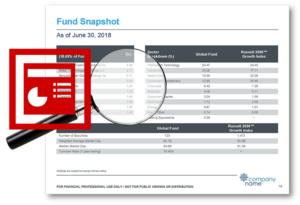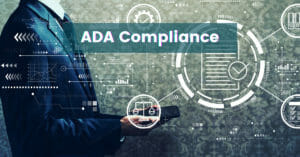The New Tailored Shareholder Rule – What ’40 Act Funds Need to Know
Just Updated:
Synthesis Technology’s Tailored Shareholder Report Planning Guide
In case you missed it, the SEC is mandating that mutual funds and ETFs shift from traditional reporting documents to something sleeker. The old reports ran dozens of pages in length and, quite frankly, have been largely ignored by their shareholders. Thus, they are being replaced by something far more useful for the average fund investor.
According to the SEC press release:
“Shareholder reports are amongst the most important documents that fund investors receive… These reports, however, often are more than 100 pages in length. As a result, a retail investor looking to understand the performance, fees, and other operations…may need to sift through extensive financial information. Today’s final rules will require fund companies to share a concise set of materials that get to the heart of the matter.”
Beginning in July 2024, mutual fund and ETF shareholders will begin receiving “Tailored Shareholder Reports.” These will be shorter, with a “visually engaging” format, and a stricter focus on the information that would be most relevant and of interest to the average shareholder.
This rule change will allow retail shareholders to more easily assess and monitor their fund investments via documents that are concise, relevant, and written in plain (read: non-jargony) English.
View our recorded webinar (8/2/23):
Are Your Systems Ready? 6 Questions to Answer About Implementing the Tailored Shareholder Rule
Please note that these new reports are in addition to existing filing and disclosure requirements – not a replacement of them. Full shareholder reports, the SAI, and full financial statement disclosure are still required and will continue to be available online via XBRL tagging and EDGAR. Financial professionals and accredited investor-types (or those who simply desire more in-depth information) will thus be able to access this detailed data online.
Fact Sheets for Fund Investors
Because of the strong implied similarities between the TSR and traditional fact sheets, effective compliance with these new rules will require Act 40 funds to have automated systems in place that can:
- manage data integration
- streamline content sharing
- create charts and graphs from that data and content, and
- create and enforce business rules for content creation.
Given Synthesis’ long experience with fund fact sheet automation, we have extensive expertise in all of these areas and thus have several recommendations about what Act 40 fund companies should be thinking about as they begin strategy planning for the coming changes in their reporting procedures.
Now is the time for fund management companies to review existing partners and procedures to ensure efficiency, reliability, responsiveness, and cost-effectiveness. We believe the opportunities and challenges presented by the TSR rule are enormous in terms of the potential to revolutionize the efficiency, costs, and impact of shareholder reporting.
At the Outset…
Make sure your partner (or internal team), is well-versed in the requirements around iXBRL tagging and filing with EDGAR. This is new and incredibly important: TSRs will need to be 100% tagged so that investors can compare fund performance across their portfolios. The data needs to be properly tagged, managed and consistent. Make sure this is on your TSR development agenda, as they are not going away. .
Also, it’s equally important to ensure that everyone involved with managing the TSRs fully understand the beginning-to-end procedures of data management, content automation, client reporting, and distribution.
If a company traditionally utilizes several partners to handle these steps, it is essential all systems are capable of full integration and can provide seamless transfer of data from start to finish.
Read our latest: Planning Guide for the SEC’s Tailored Shareholder Report Rule
Design Matters
Most fund companies allocate important resources to their marketing, sales, and client service collateral with the intent of meeting many of the same goals that are being embraced by the new rule: Make content that is meaningful. Enhance the company’s brand. Ensure accuracy.
So there is every reason for the new TSRs to receive the same level of creative scrutiny and investment – after all, the SEC’s mandate is for a “visually engaging” format: fonts, colors, layouts, graphics – each of these elements must find a home here.
The challenge in designing something like a TSR is that there needs to be equal emphasis on the aesthetics and the mechanical aspects of each page. This becomes especially difficult when one factors into consideration all the small differences between share classes within a single fund, as well as those between different products.
The ultimate design must support all the variations in the product line, data, disclosures, and branding without dissolving into chaos.
In short, know that one of the biggest challenges will be creating templates that account for all these variations and can handle them with aplomb. The design team should thus mockup as many sample documents as in practicable, using real data to ensure the formatting works and can account for each extreme in the document’s potential content (by “extreme” we mean highly differentiated from a “standard” product).
We also recommend at the outset that fund managers pay strict attention to any/all existing style guides to ensure consistency across the firm’s materials. In our view, many firms would be wise to begin their design effort by looking at their existing factsheets for inspiration.
Content Sharing
Perhaps the biggest difference between the proposed TSR and traditional shareholder reports is that a factsheet-style report produced at volume, benefits from the same efficiencies as do marketing factsheets, via true automation.
In our lexicon, “automation” accounts for
- existing business rules
- shared libraries of content and disclosures
- product data
- market data
- firm information, and
- integrated design capabilities.
Systems like the ones built and refined by Synthesis, that have long brought profound efficiencies to scaled, volume production of factsheets, pitch books, commentaries and other documents can now be applied to these new TSRs.
This expertise is a function of both technical capability and professional experience – a logic that might be somewhat novel to the reporting teams at mutual funds, as well as the vendors who support document productions as almost “one-off” entities with separate editorial cycles.
Our recommendation is for Act 40 fund companies to embrace procedures that place a premium on automated document production while also looking for solutions that are firmly rules- and data-driven.
For more best practices and strategy, click here to read our Tailored Shareholder Report Planning Guide
Strategy for the At-Large Datasets
The SEC regulations stipulate the TSRs contain 14 datasets, including principal markets (for ETFs), statements on material changes, expenses, performance discussions, fund stats, holdings, and name/ticker/shareclass, among others.
Based on our experience with fact sheet automation and design, these datasets may fit into two pages, which would clearly meet the new standard. And while the SEC has been uncharacteristically nebulous regarding specific document length, it is our guess that these TSRs will eventually find a home in the three to four–page range, meaning that fund companies will have some additional room with which to work.
However, as fund companies familiar with the ins-and-outs of traditional print products well know, there can be a significant cost differential between 2 and 3, or 3 and 4 pages. For this reason alone, it’s important for Act 40 fund companies to partner with a consultant well-versed in efficient design and layout, given the burden of higher production costs between given page sets.
For these “at-large” datasets, we would recommend fund companies allow three interrelated imperatives to help guide the decision-making about what to include: Client service. Education. Marketing.
For example, if there are advantages to a fund’s approach or if there are specific metrics by which the fund can be favorably compared (but might not necessarily be “kitchen table”-type analytics), fund companies might want to consider their inclusion. Similarly, use of non-traditional metrics offers an educational opportunity, which enhances the relationship and can demonstrate a clear understanding of what investors both need to know and want to know.
Artfully establishing and maintaining such a balance is essential across each of these three business imperatives.
In short, it allows fund management firms some flexibility in terms of choosing metrics whose sole purpose is to put their work in the best possible light while still remaining compliant with the new regulations.
In the End…
Whenever the SEC offers new guidance to better protect investors, there is always an adjustment period for asset managers – not unlike a new house that creaks and groans as it settles – to figure out exactly how all the nuances and generalities embedded in the SEC’s rulemaking will play out in the market. It’s here where the fund reporting team becomes an essential partner in TSR development.
Contact us to learn more and please watch for future content from us on this subject as we will be sharing details and insights gleaned from our work with clients on these documents.
For now, please refer to our latest, Planning Guide for the New Tailored Shareholder Rule.
Here are some related resources that might interest you:







 Compare the Top 3 Finserv Content Automation Vendors [White paper]
Compare the Top 3 Finserv Content Automation Vendors [White paper] Create Pitchbooks the Drive Sales [White paper]
Create Pitchbooks the Drive Sales [White paper] Build vs. Buy: Should Your Financial Services Firm Outsource or Insource Marketing Technology? [White paper]
Build vs. Buy: Should Your Financial Services Firm Outsource or Insource Marketing Technology? [White paper]  10 Tips for Rebranding your Fund Marketing Documents [White paper]
10 Tips for Rebranding your Fund Marketing Documents [White paper]

